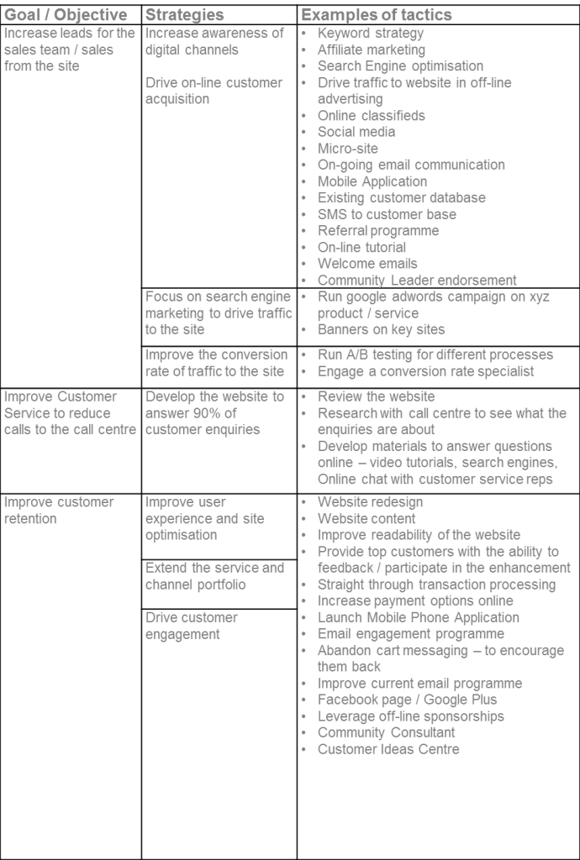Digital Marketing Strategy Part 4: Decide on Your Strategy & Tactics

If you've been following this series, you’re now well on your way to developing a digital strategy (Click here to read part 1). You know what you need to achieve…. Now it’s time to think in more detail about how, what, who, where, when & why?

Decide on your strategy & tactics
Your strategy and your tactics will very much depend on your digital objectives, which fall out of your business objectives. People often get them confused, so I love to use this example that I found online:
Goal: Win the war.
Strategy: “Divide and conquer.”
Tactics:
- CIA spies gather intelligence.
- Navy Seals knock out enemy communications.
- Paratroopers secure the airports.
- Armored Divisions race in and divide the opposing army’s forces.
- Drone attacks take out the enemy leadership.
- An overwhelming force of infantry invade.
- Hand-to-hand combat
But how does that translate into digital marketing? The strategy is the what and the tactics are the how & who…
Examples: (Note – these goals need to be defined properly as SMART objectives)
These are just some examples of digital strategies and tactics. In most businesses, the key digital asset is the website and so can logically be a starting point.
Website
Take a good hard look at your website.
If you are looking for increased leads or increased sales, explore how well your website performs in terms of people searching on Google. If you are looking to offer customer service to reduce in bound phone calls then think about how easy it is for people to find the answers to their questions… And do you have on-line customer service or a prominent phone number so that they can call you if they get stuck?
Generally people are looking for increased brand awareness and increased leads / sales, so the first place to start is to think about the keywords that people will use to search for the product or service that you offer.
You can find this out in a number of ways:
- If you have some website analytics software (like Google Analytics), then take a look at what keywords people are using to get to your website.
- Use a tool such as Google trends (http://www.google.com/trends/) or the keyword tool within Google Adwords to see what your potential customers are searching on.
- Work with a reputable SEO firm who will help you better understand the market and come up with a keyword strategy.
Next you need to build your website around these keywords. Your page titles, your page descriptions, your heading and your copy all need to reflect what people are looking for. In many cases you can do this yourself, but I would recommend working with an SEO expert. They can usually immediately help you increase traffic to your site.
There are so many digital marketing things to think about:
- Your website
- Search Engine Optimisation & keyword strategies
- Search Engine Marketing – banners & Google Adwords campaigns
- Your customer database & CRM (Customer Relationship Management)
- Email marketing
- Mobile websites
- Videos
- Blogs
- Social Media – Facebook, LinkedIn, Pinterest, Twitter, Google +
- Places / Geomarketing
- Directories
- Competitions
I can’t possibly cover all of them and how you can use them for your business in one article, but remember that they are all just marketing channels. So, here are some tips / pointers around how you decide what is relevant.
Tips / Pointers
- What channels are best for your target audience?
- Which ones can work for the objectives you need to achieve?
- WIIFM? – Ask yourself the question – What Is In It For Me? Not literally you, but from your customer’s perspective ie: Why will they come to your social media site? What will they get out of it?
- What can you afford to spend? Both in money & in time to maintain it.
- Don’t forget the humble email. If there’s a WIIFM then you will get results.
- Make sure that you have the resources to execute on your plan and that there aren’t any bottlenecks in your environment.
- Use a timeline & resource management (or fancy project management software if you have it) to make sure you can deliver all that you need to.
- Have a social media diary that outlines what you will write & post and when.
- Don’t post the same thing to every social media site – they attract different audiences so customise your message.
- Don’t forget the offline environment! - Ensure that your offline tactics support & reflect your online tactics. Have your website & social media addresses on all of your offline materials.
Next week we’ll look at testing, measuring & rewarding success… French Champagne or Central Otago Pinot here we come.
Other parts in this series:
- Digital Marketing Strategy Part 1: What Is a Good Strategy for My Business?
- Digital Marketing Strategy Part 2: Analysing Your Current Strategy
- Digital Marketing Strategy Part 3: Developing Digital Objectives
- Digital Marketing Strategy Part 4: Decide on Your Strategy & Tactics
- Digital Marketing Strategy Part 5: Test, Measure & Improve
This blog series is written by Debra Chantry, an Executive in Residence (EiR) & Business Coach at The Icehouse working with start-ups and established business to help them achieve their growth goals. Debra is also the owner of Ventell, a Strategic Consultancy focused on growing businesses profitably through business coaching, business and digital strategies and governance.


.jpg?height=500&name=Untitled%20design%20(5).jpg)
